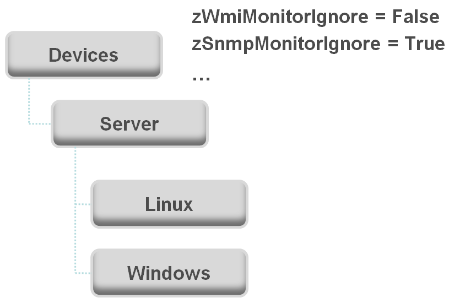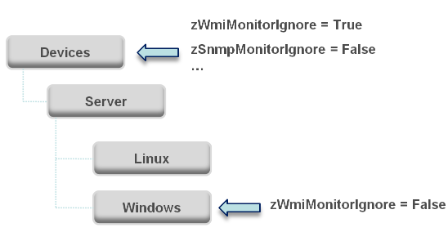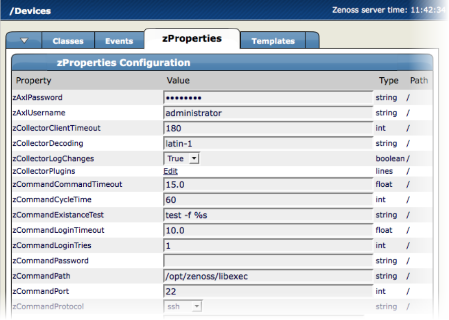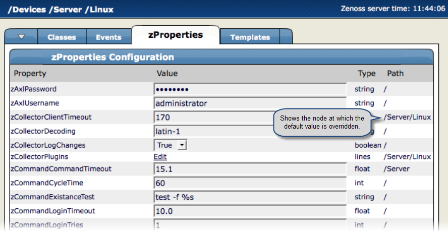#1. zProperties
zProperties are individual values that exist on the major configuration organizers in the system:
Device classes
Device class zProperties control the way monitoring is gathered from devices after they have been added to the system.
Networks
Network zProperties control the way Zenoss performs auto-discovery.
Events
Event zProperties control the rules that process events as they are added to the system.
Services and processes
Service and process zProperties describe how operating system components are monitored by the Zenoss monitoring daemons.
zProperties can be configured for:
All items
Single devices
Multiple devices in the device hierarchy
zProperties settings can be added to any ZenPacks you create, allowing you to add customized zProperties to the system when you add ZenPacks.
#1.1. zProperties Inheritance and Override
The following diagram illustrates a portion of Zenoss' standard device class hierarchy. (A device class is a special type of organizer used to manage how the system models and monitors devices.)
At the root of the device hierarchy is the Devices object. All device class zProperties are defined here, and their values are the default values for the entire hierarchy.
The illustration further shows two defined zProperties:
zWmiMonitorIgnore - Turns off all daemons that use WMI. By default its value at the root of the hierarchy is False.
zSNMPMonitorIgnore - Turns off all daemons that use SNMP. By default, its value at the root of the hierarchy is True.
Through inheritance, properties defined at the root of the hierarchy apply to all objects beneath that node. So, at the /Devices/Server/Linux level of the device class hierarchy, the value of these two properties is the same as at /Devices, even though the property is not set explicitly at /Devices/Server/Linux. Inheritance simplifies system configuration, because default values set at the root level apply to all devices irrespective of their device class.
To further customize the system, you can change a specific zProperty further down the hierarchy without having to change the definitions of other zProperties. As shown in the following illustration, the value of zWmiMonitorIgnore is changed so that WMI monitoring is performed at the /Devices/Server/Windows level.
This locally defined value for zWmiMonitorIgnore overrides the value set at the root of the hierarchy. No other properties at this level are affected by this local change; they continue to inherit the value set at the root.
zProperties allow you to configure the system at a very granular level, down to a particular device. For example, in the following illustration, the device named dev.zenoss.com has the value of SNMP community set to private. This overrides the root value (public).
If you change the SNMP Community value of dev.zenoss.com to public, it matches the value set at the root, but is still explicitly defined. Only if you remove the locally defined property does it again inherit the value of the property set at the root.
#1.1.1. User Interface View
This section further illustrates the characteristics of zProperties from the user interface perspective. The following screen shows zProperties defined at the root level.
As shown in the previous screen, the zCollectorClientTimeout zProperty has a default value of 180. In the next screen, the value has been set to 170 at /Devices/Server/Linux, overriding the default value at this node of the hierarchy.
To then remove the override and once again inherit the value from the root of the hierarchy, go to the Delete Local Property area of the zProperties page.
#1.2. zProperty Types
zProperties can be one of these types:
String - Text value that can be ASCII or Latin-1 encoded
Integer - Whole number
Float - Number that can has a decimal value
Boolean - True or false
Lines - List of values separated by a return. Zenoss stores these as an array.
#1.3. Event zProperties
To access Event zProperties, from the left navigation menu, select Event and click the zProperties tab. You can also set zProperties for any event class in the events hierarchy by navigating to the level in the event hierarchy where you want to set the zProperty and clicking the zProperties tab.
Table 5.1. Event zProperties
| Property Name | Property Type | Description |
|---|---|---|
| zEventAction | string | Specifies the location in which an event will be stored. Possible values are: status, history and drop. Default is status, meaning the event will be an “active” event. History sends the event directly to the history table. Drop tells the system to discard the event. |
| zEventClearClasses | lines | Lists classes that a clear event should clear (in addition to its own class). |
| zEventSeverity | int | Overrides the severity value of an event. If the value is -1, it is ignored. Possible values are 0 – 5. |
#1.4. Device zProperties
To access Device zProperties, from the left navigational menu, select Devices and then click the zProperties tab. You can also select any of the Device Classes and the zProperties tab to set zProperties anywhere in the Device hierarchy. To set zProperties for an individual Device, navigate to that device, open the page menu, select the More option and then the zProperties tab.
Table 5.2. Device zProperties
| Property Name | Property Type | Description |
|---|---|---|
| zCollectorClientTimeout | int | Allows you to set the timeout time of the collector client in seconds |
| zCollectorDecoding | string | Converts incoming characters to Unicode. |
| zCollectorLogChanges | Boolean | Indicates whether to log changes. |
| zCollectorPlugins | lines | Links to tall collector plugins for this device. |
| zCommandCommandTimeout | float | Specifies the time to wait for a command to complete. |
| zCommandCycleTime | int | Specifies the cycle time you use when executing zCommands for this device or organizer. |
| zCommandExistanceTest | string | *** |
| zCommandLoginTimeout | float | Specifies the time to wait for a login prompt. |
| zCommandLoginTries | int | Sets the number of times to attempt login. |
| zCommandPassword | string | Specifies the password to use when performing command login. |
| zCommandPath | string | Sets the default path where ZenCommand plug-ins are installed on the local Zenoss box (or on a remote box where SSH is used to run the command). |
| zCommandPort | int | Specifies the port to connect to when performing command collection. |
| zCommandProtocol | string | Establishes the protocol to use when performing command collection. Possible values are SSH and telnet. |
| zCommandSearchPath | lines | Sets the path to search for any commands. |
| zCommandUsername | string | Specifies the user name to use when performing command collection. |
| zDeviceTemplates | lines | Sets the templates associated with this device. Linked by name. |
| zFileSystemMapIgnoreNames | string | Sets a regular expression of file system names to ignore. |
| zFileSystemMapIgnoreTypes | lines | Do not use. |
| zIcon | lines | Specifies the icon to represent the device wherever device Icon is shown, such as on the network map and device status page. Most devices, including Windows servers, Linux servers, and routers, have images set by default. |
| zIfDescription | Boolean | Shows the interface description field in the interface list. |
| zInterfaceMapIgnoreNames | string | Filters out interfaces that should not be discovered. |
| zInterfaceMapIgnoreTypes | string | Filters out interface maps that should not be discovered. |
| zIpServiceMapMaxPort | int | Specifies the highest port to scan. The default is 1024. |
| zKeyPath | lines | Sets the path to the key to access a device. |
Table 5.3. Device zProperties
| Property Name | Property Type | Description |
|---|---|---|
| zLinks | text | Specifies a place to enter any links associated with the device. |
| zLocalInterfaceNames | string | Regular expression that uses interface name to determine whether the IP addresses on an interface should be incorporated into Zenoss' network map. For instance, a loopback interface "lo" might be excluded. |
| zLocalIpAddresses | int | Specifies IP addresses that should be excluded from the network map (for example. 127.x addresses). If you have addresses that you reuse for connections between clustered machines they might be added here as well. |
| zMaxOIDPerRequest | int | Sets the maximum number of OIDs to be sent by Zenoss' SNMP collection daemons when querying information. Some devices have small buffers for handling this information so the number should be lowered. |
| zPingInterfaceDescription | string | A catalog query string that will find interfaces to be pinged by description. |
| zPingInterfaceName | string | A catalog query string that will find interfaces to be pinged by name. |
| zPingMonitorIgnore | Boolean | Whether or not to ping the device. |
| zProdStateThreshold | int | Production state threshold at which Zenoss will begin to monitor a device. Default of 500 equals Pre-Productions. |
| zPythonClass | string | DO NOT USE |
| zRouteMapCollectOnlyIndirect | Boolean | Only collect routes that are directly connected to the device. |
| zRouteMapCollectOnlyLocal | Boolean | Only collect local routes. (These usually are manually configured rather than learned through a routing protocol.) |
| zSnmpAuthPassword | string | The shared private key used for authentication. Must be at least 8 characters long. |
| zSnmpAuthType | string | Use either "MD5" or "SHA" signatures to authenticate SNMP requests |
| zSnmpCommunities | lines | Array of SNMP community strings that the ZenModeler will try to use when collecting SNMP information. |
| zSnmpCommunity | string | Community to be used when collecting SNMP information. If it is different than what is found by ZenModeler, it will be set on the modeled device. |
| zSnmpMonitorIgnore | Boolean | Whether or not to ignore monitoring SNMP on a device. |
| zSnmpPort | int | Port that the SNMP agent listens on. |
| zSnmpPrivPassword | string | The shared private key used for encrypting SNMP requests. Must be at least 8 characters long. |
| zSnmpPrivType | string | "DES" or "AES" cryptographic algorithms. |
| zSnmpSecurityName | string | The Security Name (user) to use when making SNMPv3 requests. |
| zSnmpTimeout | float | Timeout time in seconds for an SNMP request |
| zSnmpTries | int | Amount of tries to collect SNMP data |
| zSnmpVer | string | SNMP version used. Valid values are v1, v2. |
Table 5.4. Device zProperties
| Property Name | Property Type | Description |
|---|---|---|
| zStatusConnectTimeout | The amount of time that the zenstatus daemon should wait before marking an IP service down. | |
| zSysedgeDiskMapIgnoreNames | Currently unused. | |
| zTelnetEnable | Boolean | When logging into a Cisco device issue the enable command to enable access during command collection. |
| zTelnetEnableRegex | string | Regular expression to match the enable prompt. |
| zTelnetLoginRegex | string | Regular expression to match the login prompt. |
| zTelnetPasswordRegex | string | Regular expression to match the password prompt. |
| zTelnetPromptTimeout | float | Time to wait for the telnet prompt to return. |
| zTelnetSuccessRegexList | lines | List of regular expressions to match the command prompt. |
| zTelnetTermLength | Boolean | On a Cisco device, set term length to Zero. |
| zWinEventlog | Boolean | Whether or not to send the log. |
| zWinEventlogMinSeverity | int | Sets minimum severity to collect from the win event log. Important to note that the higher the number, the lover the severity. 1 being the most sever and 5 being the least severe. |
| zWinPassword | string | The password used to remotely login if it is a Windows machine. |
| zWinServices | ||
| zWinUser | string | User name used to remotely login if it is a Windows machine. |
| zWmiMonitorIgnore | Boolean | Use to turn on or off all WMI monitoring. |
| zXmlRpcMonitorIgnore | Boolean | Use to turn on or off all XML/RPC monitoring. |
#1.5. Service zProperties
To access Service zProperties, from the left navigation menu, select Services, and then click the zProperties tab. You can also access the Service zProperties tab anywhere in the services hierarchy by going to the level where you want to set the zProperty and clicking the zProperties tab.
Table 5.5. Service zProperties
| Property Name | Property Type | Description |
|---|---|---|
| zFailSeverity | int | Determines what severity to send for the specified service. |
| zHideFieldsFromList | lines | Fields to hide from Services instance list |
| zMonitor | Boolean | Tells whether or not to monitor a service. |
#1.6. Process zProperties
To access Process zProperties, from the left navigation menu, select Processes, and then click the zProperties tab. You can also access the Process zProperties tab anywhere in the processes hierarchy by going to the level where you want to set the zProperty and clicking the zProperties tab.
Table 5.6. Process zProperties
| Property Name | Property Type | Description |
|---|---|---|
| zAlertOnRestart | Boolean | Determines whether or not to send an event if the specified process is restarted. |
| zCountProcs | int | Determines the number of instances of the process that are running. |
| zFailSeverity | int | Determines what severity to send for the specified process. |
| zMonitor | Boolean | Tells whether or not to monitor a process. |
#1.7. Network zProperties
To access Network zProperties, from the left navigation menu, select Networks, and then click the zProperties tab. You can also access the zProperties tab for any sub-network that exists with in the Networks page.
Table 5.7. Network zProperties
| Property Name | Property Type | Description |
|---|---|---|
| zAutoDiscover | Boolean | Should zendisc perform auto-discovery on this network |
| zDefaultNetworkTree | lines | List of netmask numbers to use when creating network containers. Default is 24, 32 which will make /24 networks at the top level of the networks tree if a network us smaller than /24. |
| zPingFailThresh | int | Number of pings to sent without being returned before Zendisc removes the device. |










